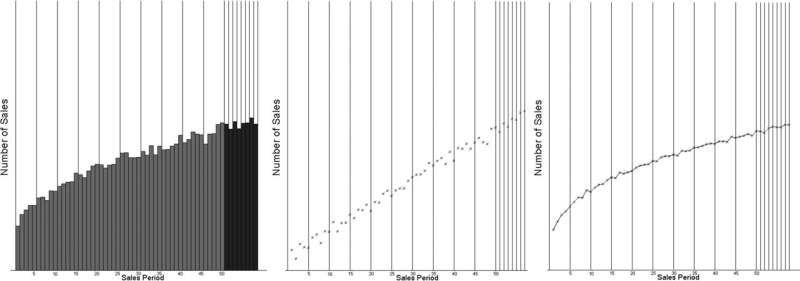This article has been reviewed according to Science X's editorial process and policies. Editors have highlighted the following attributes while ensuring the content's credibility:
fact-checked
trusted source
proofread
New study suggests that when forecasting trends, reading a bar chart versus a line graph biases our judgement

A new study suggests that the format in which graphs are presented may be biasing people into being too optimistic or pessimistic about the trends the graphs display.
Academics from City, University of London and University College London found that when people made predictions about how a trend would develop over time, they made lower judgements when the trend was presented as a 'bar chart' type graph than when exactly the same data was presented as a line graph or a graph consisting of a set of data points only.
The study comprised four experiments conducted online with over four thousand participants in total. In the first two experiments, participants were each given a single graph, either a bar chart, line graph or point graph, populated with 50 datapoints representing weekly sales made by a fictitious company. Participants had to click on the graph to show how many sales they thought the company would make in the eight weeks that followed. They were incentivised to give accurate responses.
In the first experiment the number of sales in the graph provided increased week on week, and participants generally forecast that sales would increase further; in the second experiment, the trends in the graph were decreasing making participants more pessimistic about sales in the future.
Nevertheless, across many different types of trend participants consistently thought sales would be lower when the data were presented as bar charts than line graphs or point graphs.
The researchers wondered whether the reason was that in bar charts the area inside the bar is usually heavily shaded and hence visually draws attention to itself, lowering participants' estimates as compared to the other types of graph where there is no shading to attract the eye and attention. However, in a third experiment, they found the same lower forecasts for bars even when the bars were left unshaded.
In a fourth experiment they tested a version of a bar chart where the bars emanated from the top of the graph rather than the bottom. While subtle trends in the data suggest this may reverse the bias, the findings were inconclusive.
Stian Reimers, Professor of Psychology and Behavioral Science at the School of Health & Psychological Sciences, City, University of London, and who led the research said, "In the past few years it seems like we have spent a lot of time looking at time series: whether it's the number of COVID cases, electricity prices or inflation rates, to try to work out what's coming next. What our research shows is that our predictions of what we think will happen next are affected not just by the trends we're looking at, but the format in which they're displayed. This obviously has implications for all of us as we try to make decisions on whether it's likely to be safe to visit vulnerable relatives, or whether we'll be able to afford to take on a mortgage."
As well as affecting the decisions that individuals make, these biases may also affect the many businesses that perform analyses like 'demand forecasting,' where historical data is used to estimate and predict customers' future demand for a product or service; specifically when these judgements are made unaided by individuals directly 'eyeballing' graphs and estimating how they think a trend is going to develop.
However, Professor Reimers believes these biases could have benefits, "It's potentially useful because these kinds of format effect might help counteract some of the other errors people make when projecting trends into the future. A lot of the other biases that people show when trying to extrapolate trends are baked into the way we see the world and hard to change. The format we use for our graphs is something we have complete control over, so it may be possible to use specific formats to help undo people's built-in biases and help people make more accurate judgements.
"Although we had a lot of participants, this is just a small set of studies. It will be interesting to see how well these findings generalize across different formats and levels of expertise, and exciting to try to find the ways of presenting data that unfolds over time in a way that helps people best capture the state of the world and most accurately predict what is likely to happen next."
The research is published open access in the International Journal of Forecasting.
More information: Stian Reimers et al, Bars, lines and points: The effect of graph format on judgmental forecasting, International Journal of Forecasting (2023). DOI: 10.1016/j.ijforecast.2022.11.003
Provided by City University London





















